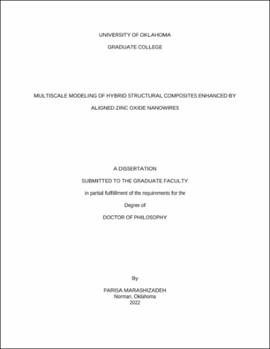| dc.description.abstract | Interfacial properties between fibers and matrix can significantly impact the overall performance of the composite structures. One pioneering approach to enhancing the interfacial properties is growing nanostructures on the fiber. Multiscale modeling is employed in this study to evaluate the interfacial properties of hybrid carbon fiber reinforced polymer (CFRP) composites enhanced by ZnO nanowire (NW) aligned on the fiber surface. Some of the critical information, such as the material properties of ZnO NW, and interfacial properties, cannot be determined easily from the experimental analysis. The hybrid composites have four distinct phases: carbon fiber, interface, aligned ZnO NW/polymer coating, and epoxy matrix. Due to the substantial length-scale differences among the four phases, a multiscale model is developed to analyze the adhesion properties of the hybrid composites. The interfacial properties between the fiber surface and the enhancement layer are investigated at the atomic scale utilizing molecular dynamics (MD) simulations. The accuracy of the molecular model is verified by conducting the tensile analysis for modeling components of the ZnO NW, the graphene sheet, and the cross-linked epoxy units. An atomistic representative volume element (RVE) is developed in which a single ZnO NW is aligned with the carbon fiber and embedded in the cross-linked epoxy.
The traction-separation behavior in both sliding mode (shear separation) and opening mode (normal separation) is evaluated. The cohesive parameters, including the peak traction and adhesion energy, are calculated in each mode. The interfacial properties of the hybrid system are compared with the simulated bare RVE containing fiber and epoxy. MD results showed that the interfacial strength is increased from 485 MPa to 1066 MPa with the ZnO NWs. Additionally, the effect of different parameters on the interfacial properties of the hybrid composite is investigated, including the ZnO NW diameter, ZnO NW length, ZnO NW/graphene crystal twisting angle, loading temperature, and loading rate. Higher interfacial properties are achieved by reducing the diameter of ZnO NW in the enhanced structures. The MD results reveal that increasing the loading temperature leads to a weaker interface. Interfacial properties are initially improved by increasing the loading rate and then becoming rate independent.
Moreover, a multiscale modeling framework is developed to investigate the effect of growing ZnO NWs on the fiber/matrix interface, and the fiber fragmentation mechanism of ZnO NW coated single fiber composite (SFC). Three different chemical groups of Carboxyl (COOH), Carbonyl (CO), and Hydroxyl (OH) with multiple grafting densities are considered as the functional groups. The traction-separation analysis shows that combining the growth of ZnO NW and graphene functionalization significantly enhances the interfacial strength in both opening and sliding mode compared with the bare and non-functionalized CFRP structure. The interface results obtained at the nanoscale are implemented in the cohesive zone model to simulate the interface at the mesoscale. The micro homogenization analysis is performed on an RVE containing ZnO NW grown on the fiber surface and embedded in the matrix to determine the effective material properties of the enhancement layer. The interface and enhancement layer properties are imported in the macroscale hybrid SFC model. The single fiber fragmentation analysis is performed on the macroscale 3D hybrid SFC model employing the UMAT user subroutine and ABAQUS finite element analysis package. The modeling results demonstrate that the load is transferred more efficiently from the matrix to carbon fiber in the ZnO NW coated than in the bare fiber model. The fiber fragmentation is increased by 73% in the hybrid composite structure, indicating the enhanced load-bearing capacity of the SFC by incorporating ZnO NW. | en_US |
